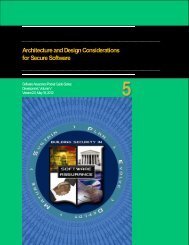Secure Coding SwA Pocket Guide - Build Security In - US-CERT
Secure Coding SwA Pocket Guide - Build Security In - US-CERT
Secure Coding SwA Pocket Guide - Build Security In - US-CERT
Create successful ePaper yourself
Turn your PDF publications into a flip-book with our unique Google optimized e-Paper software.
<strong>Secure</strong> <strong>Coding</strong> PracticesCWE/SANS Top 25 Error List/OWASP Top 10 ListMITRE, coordinated with SANS, has published a list of the most common programming errors, and OWASP has done the samefor the web application space. These lists represent the actual state of secure coding in current development efforts across manyplatforms and languages. There is little excuse for a development team to produce software that contains these errors, as theycan be specifically checked for and mitigated during the coding process. All members of the development team should be awareof the items on these lists, their causes, mitigations and relative applicability to the current project effort. At code reviews, thesespecific elements should be verified as being appropriately handled by the code.CWE/SANS Top 25 Most Dangerous Software ErrorsThe CWE/SANS Top 25 Most Dangerous Software Errors is a list of the most widespread, critical errors that can lead to seriousvulnerabilities in software. They are often easy to find, and easy to exploit. These software errors are dangerous because theyprovide the attackers a gateway to completely take over the software, steal data, or prevent the software from performing itsrequired functions.The Top 25 list is a tool to educate and aware the programmers of the kinds of vulnerabilities that plague the software industry,and how this can be prevented by identifying and avoiding the all-too-common mistakes that occur before the software is evenshipped. Software customers can use the same list to help them to ask for more secure software. Researchers in softwaresecurity can use the Top 25 to focus on a narrow but important subset of all known security weaknesses. Finally, softwaremanagers and CIOs can use the Top 25 list as a measuring stick of progress in their efforts to secure their software.OWASP Top 10 Most Critical Web Application <strong>Security</strong> RisksThe primary aim of the OWASP Top 10 is to educate developers, designers, architects, managers, and organizations about theconsequences of the most important web application security weaknesses. The Top 10 provides basic techniques to protectagainst these high risk problem areas –and also provides guidance on where to go from here.Key Practices <strong>Pocket</strong> <strong>Guide</strong>This pocket guide focuses on key practices for preventing and mitigating the most egregious exploitable software weaknesses.The Key Practices pocket guide references the Common Weakness Enumeration (CWE) and the CWE/SANS Top 25 MostDangerous Programming Errors list as resources in guiding secure software practices. It has been a valuable resource inproviding more in depth information about the CWEs and the Top 25 Most Dangerous Programming Errors.The practices are not represented as being complete or comprehensive; yet they do provide a focus for getting started in <strong>SwA</strong>efforts.Validate and Encode <strong>In</strong>put<strong>In</strong>jection attacks are commonly performed against applications. They can take the form of format string attacks in C or cross-sitescripting attacks in web scripting languages. An application that accepts user input and forwards it to the output or some trustedfunction can be targeted for attack. As a result, it is important to properly validate input to ensure that it meets the application’sexpectations (e.g., by verifying that the input has a certain length and contains no “special” HTML or meta characters and bysecurely handling any invalid input). <strong>In</strong> cases where input validation can allow potentially malicious characters (e.g., “
















